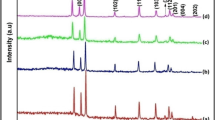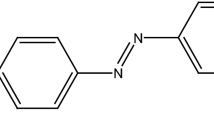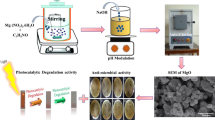Abstract
In this project, the prime focus was to synthesize zinc oxide nanoplates (ZnO-Nps) by a reliable, simple, and low cost facile hydrothermal method. Zinc acetate was used as major precursors; the synthesis was standardized in a 100 mL autoclave, at 180 °C for 24 h which results in nanoplates with 150–300 nm width and thickness 10–60 nm size and mesoporous nature with a specific surface area 126 cm2 g−1. The prepared sample was characterized by X-ray powder diffraction (XRPD), scaning electron microscopy (SEM), transmission electron microscopy (TEM), energy dispersive microscopy (EDS), Fourior transfer infrared (FTIR) spectroscopy, X-ray photo electron microscopy (XPS), Brunauer–Emmett–Teller (BET), Photoluminance (PL), and Electrochemical impedance spectroscopy (EIS) techniques. For application purposes, photocatalytic and antimicrobial activities of ZnO-Nps were studied systematically. The material was made photo-active under visible light irradiation for the degradation of the Methyl orange dye in aqueous media. The antimicrobial activity of ZnO-Nps was checked by time kill method, presented the inhibition of growth against clinical isolates of Methicillin-resistant Staphylococcus aureus (MRSA) and Escherichia coli (E. coli) after 24 h. However, 12.5 and 6.25 µg is minimal inhibitory concentration (MIC) and 25 and 12.5 µg minimal bactericidal concentration (MBC) of ZnO-Nps against MRSA and E. coli respectively.











Similar content being viewed by others
References
N. A. Shad, et al. (2019). Photocatalytic degradation performance of cadmium tungstate (CdWO4) nanosheets-assembly and their hydrogen storage features. Ceram. Int. 45, 19015–19021.
M. M. Sajid, et al. (2019). Fast Surface charge transfer with reduced band gap energy of FeVO4/graphene nanocomposite and study of its electrochemical property and enhanced photocatalytic activity. Arab. J. Sci. Eng. 44, 6659–6667.
Y. Li, X. Xiao, and Z. Ye (2019). Fabrication of BiVO4/RGO/Ag3PO4 ternary composite photocatalysts with enhanced photocatalytic performance. Appl. Sur. Sci. 467, 902–911.
M. M. Sajid, et al. (2018). Visible light assisted photocatalytic degradation of crystal violet dye and electrochemical detection of ascorbic acid using a BiVO4/FeVO4 heterojunction composite. RSC Adv. 8 (42), 23489–23498.
J. Zhu, et al. (2013). Magnetic nanocomposites for environmental remediation. Adv. Powder Technol. 24 (2), 459–467.
A. Ashour, et al. (2006). Physical properties of ZnO thin films deposited by spray pyrolysis technique. App. Sur. Sci. 252 (22), 7844–7848.
L. Zhang, et al. (2012). Efficient removal of methylene blue over composite-phase BiVO4 fabricated by hydrothermal control synthesis. Mater. Chem. Phys. 136 (2–3), 897–902.
S. G. Babu, et al. (2019). Synergistic effect of sono-photocatalytic process for the degradation of organic pollutants using CuO-TiO2/rGO. Ultrason. Sonochem. 50, 218–223.
J. He, et al. (2019). Superoxide/peroxide chemistry extends charge carriers lifetime but undermines chemical stability of CH3NH3PbI3 exposed to oxygen: time-domain ab initio analysis. J. Am. Chem. Soc. 141 (4), 5798–5807.
S. Kumar, et al., Photocatalytic degradation of organic pollutants in water using graphene oxide composite,. A new generation material graphene: applications in water technology. Springer, New York, pp 413–438.
M. M. Sajid, et al. (2019). Hydrothermal fabrication of monoclinic bismuth vanadate (m-BiVO4) nanoparticles for photocatalytic degradation of toxic organic dyes. Mater. Sci. Eng. B 242, 83–89.
X. Cheng, et al. (2004). ZnO nanoparticulate thin film: preparation, characterization and gas-sensing property. Sens. Actuators B 102 (2), 248–252.
S. S. Joshi, et al. (2006). Role of ligands in the formation, phase stabilization, structural and magnetic properties of α-Fe2O3 nanoparticles. J. Nanopart. Res. 8 (5), 635–643.
Y. Huang, et al. (2006). Controlled synthesis and field emission properties of ZnO nanostructures with different morphologies. J. Nanosci. Nanotechnol. 6 (3), 787–790.
S. Y. Lee, et al. (2005). Fabrication of ZnO thin film diode using laser annealing. Thin Solid Films 473 (1), 31–34.
Z. L. Wang, et al. (2004). Semiconducting and piezoelectric oxide nanostructures induced by polar surfaces. Adv. Funct. Mater. 14 (10), 943–956.
Z. L. Wang (2004). Zinc oxide nanostructures: growth, properties and applications. J. Phys. Condens. Matter. 16 (25), R829.
M. Suchea, et al. (2006). ZnO transparent thin films for gas sensor applications. Thin Solid Films 515 (2), 551–554.
W. Tress, et al. (2019). Performance of perovskite solar cells under simulated temperature-illumination real-world operating conditions. Nat. Energy. 4, 568–574.
H.-L. Guo, et al. (2015). Oxygen deficient ZnO1–x nanosheets with high visible light photocatalytic activity. Nanoscale 7 (16), 7216–7223.
D. Lamas, G. Lascalea, and N. W. de Reca (1998). Synthesis and characterization of nanocrystalline powders for partially stabilized zirconia ceramics. J. Eur. Ceram. Soc. 18 (9), 1217–1221.
S. Bhaduri and S. Bhaduri (1997). Enhanced low temperature toughness of Al2O3-ZrO2 nano/nano composites. Nanostr. Mater. 8 (6), 755–763.
R.-C. Wang and C.-C. Tsai (2009). Efficient synthesis of ZnO nanoparticles, nanowalls, and nanowires by thermal decomposition of zinc acetate at a low temperature. Appl. Phys. A 94 (2), 241–245.
M. Ristić, et al. (2005). Sol–gel synthesis and characterization of nanocrystalline ZnO powders. J. Alloys Compd. 397 (1), L1–L4.
Y.-H. Ni, et al. (2005). Hydrothermal preparation and optical properties of ZnO nanorods. Mater. Sci. Eng. B 121 (1), 42–47.
N. Scarisoreanu, et al. (2005). Properties of ZnO thin films prepared by radio-frequency plasma beam assisted laser ablation. App. Sur. Sci. 247 (1), 518–525.
S.-S. Chang, et al. (2002). Luminescence properties of Zn nanowires prepared by electrochemical etching. Mater. Lett. 53 (6), 432–436.
A. K. Zak, et al. (2013). Sonochemical synthesis of hierarchical ZnO nanostructures. Ultrason. Sonochem. 20 (1), 395–400.
M. Kooti and A. Naghdi Sedeh (2012). Microwave-assisted combustion synthesis of ZnO nanoparticles. J. Chem. 2013, 1–4.
O. Singh, N. Kohli, and R. C. Singh (2013). Precursor controlled morphology of zinc oxide and its sensing behaviour. Sens. Actuators B 178, 149–154.
A. Shetty and K. K. Nanda (2012). Synthesis of zinc oxide porous structures by anodization with water as an electrolyte. Appl. Phys. A 109 (1), 151–157.
D. Rajesh, B. V. Lakshmi, and C. Sunandana (2012). Two-step synthesis and characterization of ZnO nanoparticles. Phys. B 407 (23), 4537–4539.
A. A. Mohamed, et al. (2020). Eco-friendly mycogenic synthesis of ZnO and CuO nanoparticles for in vitro antibacterial, antibiofilm, and antifungal applications. Biol Trace Elem Res. https://doi.org/10.1007/s12011-020-02369-4.
A. A. Mohamed, et al. (2019). Fungal strain impacts the shape, bioactivity and multifunctional properties of green synthesized zinc oxide nanoparticles. Biocatal. Agric. Biotechnol. 19, 101103.
A. Fouda, et al. (2020). Optimization of green biosynthesized visible light active CuO/ZnO nano-photocatalysts for the degradation of organic methylene blue dye. Heliyon 6 (9), e04896.
A. Fouda, et al. (2018). In-Vitro cytotoxicity, antibacterial, and UV protection properties of the biosynthesized zinc oxide nanoparticles for medical textile applications. Microb. Pathog. 125, 252–261.
S. S. Salem and A. Fouda (2020). Green synthesis of metallic nanoparticles and their prosective biotechnological applications: an overview. Biol. Trace Elem. Res. 199 (1), 344–370.
A. Vázquez, I. A. López, and I. Gómez (2013). Growth mechanism of one-dimensional zinc sulfide nanostructures through electrophoretic deposition. J. Mater. Sci. 48 (6), 2701–2704.
S. Kang, et al. (2013). Hydrothermal conversion of lignin: a review. Renew. Sust. Energy Rev. 27, 546–558.
D. Chen, X. Jiao, and G. Cheng (1999). Hydrothermal synthesis of zinc oxide powders with different morphologies. Solid State Commun. 113 (6), 363–366.
N. A. Shad, et al. (2019). Photocatalytic investigation of cadmium oxide nanosheets prepared by hydrothermal method. Arab. J. Sci. Eng. 44, 6669–6675.
L. Gan, et al. (2018). The fabrication of bio-renewable and recyclable cellulose based carbon microspheres incorporated by CoFe2O4 and the photocatalytic properties. J. Clean. Prod. 196, 594–603.
A. Geng, et al. (2018). Highly efficient visible-light photocatalyst based on cellulose derived carbon nanofiber/BiOBr composites. Cellulose 25 (7), 4133–4144.
K. Leng, et al. (2018). Construction of functional nanonetwork-structured carbon nitride with Au nanoparticle yolks for highly efficient photocatalytic applications. Chem. Commun. 54 (52), 7159–7162.
M. Li, et al. (2019). Novel Z-scheme visible-light photocatalyst based on CoFe2O4/BiOBr/graphene composites for organic dye degradation and Cr(VI) reduction. App. Sur. Sci. 478, 744–753.
C.-T. Yang, et al. (2016). A novel heterojunction photocatalyst, Bi2SiO5/gC3N4: synthesis, characterization, photocatalytic activity, and mechanism. RSC Adv. 6 (47), 40664–40675.
M. M. Sajid, et al. (2019). Facile synthesis of Zinc vanadate Zn3 (VO4) 2 for highly efficient visible light assisted photocatalytic activity. J. Alloys Compd. 775, 281–289.
S. Agarwal, et al. (2019). Gas sensing properties of ZnO nanostructures (flowers/rods) synthesized by hydrothermal method. Sens. Actuators B 292, 24–31.
M. Mahendiran, et al. (2019). Structural and optical analysis of 1D zinc oxide nanoparticles synthesized via hydrothermal method. Mater. Today: Proc. 8, 412–418.
R. Saravanan, et al. (2013). Synthesis, characterization and photocatalytic activity of novel Hg doped ZnO nanorods prepared by thermal decomposition method. J. Mol. Liq. 178, 88–93.
T. Karnan and S. A. S. Selvakumar (2016). Biosynthesis of ZnO nanoparticles using rambutan (Nephelium lappaceum L.) peel extract and their photocatalytic activity on methyl orange dye. J. Mol. Struct. 1125, 358–365.
L. Chen, et al. (2012). Flower-like Bi2O2CO3: facile synthesis and their photocatalytic application in treatment of dye-containing wastewater. Chem. Eng. J. 193, 123–130.
J. Kaur, S. Bansal, and S. Singhal (2013). Photocatalytic degradation of methyl orange using ZnO nanopowders synthesized via thermal decomposition of oxalate precursor method. Phys. B 416, 33–38.
J. Iqbal, et al. (2015). Facile synthesis of Zn doped CuO hierarchical nanostructures: structural, optical and antibacterial properties. AIP Adv. 5 (12), 127112.
A. Arshad, et al. (2017). Graphene nanoplatelets induced tailoring in photocatalytic activity and antibacterial characteristics of MgO/graphene nanoplatelets nanocomposites. J. Appl. Phys. 121 (2), 024901.
R. M. Douglas, et al. (1987). Failure of effervescent zinc acetate lozenges to alter the course of upper respiratory tract infections in Australian adults. Antimicrob. Agents Chemother. 31 (8), 1263–1265.
C. W. Stratton, M. P. Weinstein, and L. B. Reller (1982). Correlation of serum bactericidal activity with antimicrobial agent level and minimal bactericidal concentration. J. Infect. Dis. 145 (2), 160–168.
O. Lupan, et al. (2007). Nanofabrication and characterization of ZnO nanorod arrays and branched microrods by aqueous solution route and rapid thermal processing. Mater. Sci. Eng. B 145 (1–3), 57–66.
S. M. Mali, et al. (2018). Ultrasensitive and bifunctional ZnO nanoplates for an oxidative electrochemical and chemical sensor of NO2: implications towards environmental monitoring of the nitrite reaction. RSC Adv. 8 (20), 11177–11185.
Y. Qiu, W. Chen, and S. Yang (2010). Facile hydrothermal preparation of hierarchically assembled, porous single-crystalline ZnO nanoplates and their application in dye-sensitized solar cells. J. Mater. Chem. A 20 (5), 1001–1006.
X. Wang, et al. (2010). Mass production of micro/nanostructured porous ZnO plates and their strong structurally enhanced and selective adsorption performance for environmental remediation. J. Mater. Chem. A 20 (39), 8582–8590.
J. H. Zeng, B. B. Jin, and Y. F. Wang (2009). Facet enhanced photocatalytic effect with uniform single-crystalline zinc oxide nanodisks. Chem. Phys. Lett. 472 (1–3), 90–95.
Z. Jing and J. Zhan (2008). Fabrication and gas-sensing properties of porous ZnO nanoplates. Adv. Mater. 20 (23), 4547–4551.
C.-L. Kuo, T.-J. Kuo, and M. H. Huang (2005). Hydrothermal synthesis of ZnO microspheres and hexagonal microrods with sheetlike and platelike nanostructures. J. Phys. Chem. B 109 (43), 20115–20121.
T. Tynell and M. Karppinen (2014). Atomic layer deposition of ZnO: a review. Semicond. Sci. Technol. 29 (4), 043001.
S. C. Lyu, et al. (2002). Low temperature growth and photoluminescence of well-aligned zinc oxide nanowires. Chem. Phys. Lett. 363 (1–2), 134–138.
I. A. Abdelhafeez, et al. (2019). Green synthesis of ultrathin edge-activated foam-like carbon nitride nanosheets for enhanced photocatalytic performance under visible light irradiation. Sustain. Energy Fuels. 3, 1764–1775.
H. Parangusan, D. Ponnamma, and M. A. A. Al-Maadeed (2019). Effect of cerium doping on the optical and photocatalytic properties of ZnO nanoflowers. Bull. Mater. Sci. 42 (4), 179.
J. E. Morales-Mendoza, et al. (2019). Structure and optical properties of ZnO and ZnO2 nanoparticles. J. Nano Res. 56, 49–62.
R. Bomila, S. Suresh, and S. Srinivasan (2019). Synthesis, characterization and comparative studies of dual doped ZnO nanoparticles for photocatalytic applications. J. Mater. Sci. 30 (1), 582–592.
P. Secrétan, et al. (2019). Imatinib: major photocatalytic degradation pathways in aqueous media and the relative toxicity of its transformation products. Sci. Total Environ. 655, 547–556.
R. Farzana, et al. (2017). Antimicrobial behavior of zinc oxide nanoparticles and β-lactam antibiotics against pathogenic bacteria. Arch. Clin. Microbiol. 8 (4), 57.
N. Jones, et al. (2008). Antibacterial activity of ZnO nanoparticle suspensions on a broad spectrum of microorganisms. FEMS Microbiol. Lett. 279 (1), 71–76.
K. R. Raghupathi, R. T. Koodali, and A. C. Manna (2011). Size-dependent bacterial growth inhibition and mechanism of antibacterial activity of zinc oxide nanoparticles. Langmuir 27 (7), 4020–4028.
M. Li, L. Zhu, and D. Lin (2011). Toxicity of ZnO nanoparticles to Escherichia coli: mechanism and the influence of medium components. Environ. Sci. Technol. 45 (5), 1977–1983.
A. A. Nash, R. G. Dalziel, and J. R. Fitzgerald, Mims’ pathogenesis of infectious disease (Academic Press, Cambridge, 2015).
Acknowledgements
Dr. Muhammad Munir Sajid is thankful to Dr. Zhengjun Zhang for supporting characterization techniques and keen interest, Tsinghua University; Beijing, China.
Funding
This work was financially supported by the State Scholarship Fund of China Scholarship Council (Grant No. 201808410144), the National Natural Science Foundation of China (Grant No. 51202107), and Foundation of Henan Educational Committee (Grant No. 20A480003).
Author information
Authors and Affiliations
Corresponding authors
Ethics declarations
Conflict of Interest
The authors declare that they have no conflict of interest.
Additional information
Publisher's Note
Springer Nature remains neutral with regard to jurisdictional claims in published maps and institutional affiliations.
Rights and permissions
About this article
Cite this article
Sajid, M.M., Shad, N.A., Javed, Y. et al. Efficient Photocatalytic and Antimicrobial Behaviour of Zinc Oxide Nanoplates Prepared By Hydrothermal Method. J Clust Sci 33, 773–783 (2022). https://doi.org/10.1007/s10876-021-02013-8
Received:
Accepted:
Published:
Issue Date:
DOI: https://doi.org/10.1007/s10876-021-02013-8




